Zennor
OS Grid reference:- SW458384
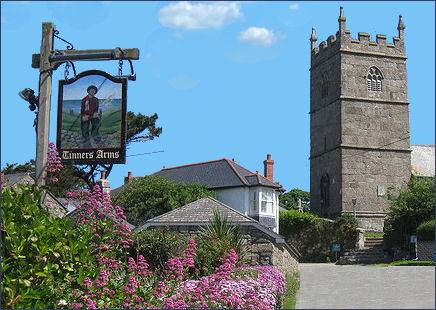 The characterful and ancient Cornish village of Zennor lies on brooding, rocky and windswept moorland a few miles from Land's End, on the coast road from St. Ives. The village is steeped in history, man has occupied the spot since the Bronze Age. The coastline around the whole of the West Penwith area of Cornwall in which the village is located is spectacular, weather worn into coves and caves, cliffs and headlands, by the relentless sea.
The characterful and ancient Cornish village of Zennor lies on brooding, rocky and windswept moorland a few miles from Land's End, on the coast road from St. Ives. The village is steeped in history, man has occupied the spot since the Bronze Age. The coastline around the whole of the West Penwith area of Cornwall in which the village is located is spectacular, weather worn into coves and caves, cliffs and headlands, by the relentless sea.
'At Zennor one sees infinite Atlantic, all peacock-mingled colours, and the gorse is sunshine itself. Zennor is a most beautiful place: a tiny granite village nestling under high shaggy moor-hills and a big sweep of lovely sea beyond, such a lovely sea, lovelier even than the Mediterranean..... It is the best place I have been in, I think' (D.H Lawrence 1916).
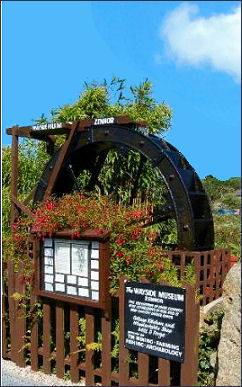 Zennor is surrounded by by farm buildings of weathered
granite and consists of a cluster of houses and a pub, the Tinner's Arms, which nestle around the village church. The village lies amongst pre-historic field systems
that can no longer be witnessed anywhere else. Human settlement around the village of Zennor can be dated from the early Bronze Age (2,000-150 BC).
Zennor is surrounded by by farm buildings of weathered
granite and consists of a cluster of houses and a pub, the Tinner's Arms, which nestle around the village church. The village lies amongst pre-historic field systems
that can no longer be witnessed anywhere else. Human settlement around the village of Zennor can be dated from the early Bronze Age (2,000-150 BC).
The Wayside Museum (pictured right and interior below left), was founded in the 1930's, and stands by a gushing stream, the museum is housed in an old mill house. It hosts displays of old mining tools, fishing nets, oil lamps and kitchen utensils from local cottage kitchens and has a working water wheel as well as tools dating from 3000BC.
Outside the Museum stands the plague stone, marking the boundary past which villagers were not allowed to pass during the time of the Black Death. The indentation in the stone was filled with vinegar, coins were placed in the vinegar to avoid contamination by the plague.
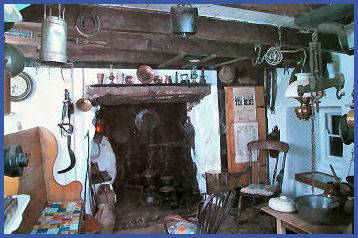 The famous Methodist John Wesley preached at Zennor in 1748. A large stone by the road which leads into the village is thought to have once been used as a pulpit by him.
The famous Methodist John Wesley preached at Zennor in 1748. A large stone by the road which leads into the village is thought to have once been used as a pulpit by him.
The author and miner's son D.H. Lawrence visited Zennor with his German wife Frieda in 1916 in an attempt to escape the German xenophobia that the First World War evoked. He stayed at the Tinners' Arms in the village and later rented Higher Tregerthen, near Zennor. During his stay Lawrence wrote 'Women in Love' He failed completely to escape the mounting suspicion of Germans, he and his wife were ordered by the police to leave the village on suspicion of being spies!
With its open log fires, stone floors and low ceilings, the village oub, the Tinner's Arms, has changed little over the years and now offers a traditional pub experience with real Cornish ales and carefully prepared food.
Zennor bears the distinction of being one of the last bastions of the ancient Cornish language. The last person to speak Cornish as her only language was said to be Dolly Pentreath, who lived and is buried near Mousehole, where her grave with its Cornish inscription may still be seen.
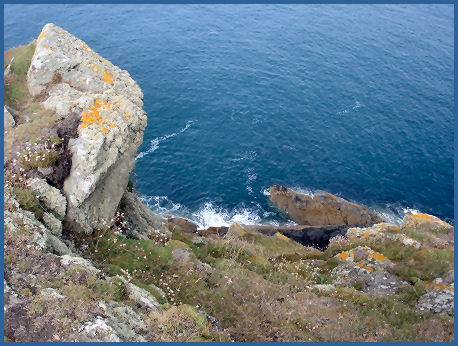 John Davey, a farmer and schoolteacher of Boswednack, Zennor who died in 1891 at the age of 79 was one of the last people with a traditional knowledge of Cornish. A memorial stone at Zennor church was erected by the St Ives Old Cornwall Society in his memory. John Mann of Boswednack, Zennor, was the last known survivor of a number of traditional Cornish speakers of the nineteenth century, he was said to have conversed in Cornish with other children, and was still alive at the age of 80 in 1914.
John Davey, a farmer and schoolteacher of Boswednack, Zennor who died in 1891 at the age of 79 was one of the last people with a traditional knowledge of Cornish. A memorial stone at Zennor church was erected by the St Ives Old Cornwall Society in his memory. John Mann of Boswednack, Zennor, was the last known survivor of a number of traditional Cornish speakers of the nineteenth century, he was said to have conversed in Cornish with other children, and was still alive at the age of 80 in 1914.
Imposing and dramatic Zennor Head, (left) a short walk from the village, consists of steep, soaring granite cliffs, which rise to two hundred feet (60.96 metres) and offer winding footpaths down to the beautiful sandy cove at their base. Zennor Head is home to a variety of wildlife, including the re-introduced Cornish Choughs. Grey seals have been sighted off the coast. Many seabirds nest on the cliffs, especially around Horseback Zawn, including Herring Gulls and fulmars.
The views of the Cornish coast from the cliffs are superb, to the north east and south west rugged Atlantic battered headlands rise steeply from the sea. While inland the view encompasses granite tors and heather carpeted moorland. To the west lies Pendour Cove which is forever linked to the myth of the mermaid of Zennor, whose mortal beauty and bewitching song lured to his watery death a sweet voiced chorister of ancient times, Matthew Trewhella. Zennor Head can be reached via footpaths from the village.
The prehistoric tomb of Zennor Quoit, a superb example of a prehistoric burial chamber, lies on the Amalveor Downs around a mile from the village which lends the quoit its name.
The chamber is well preserved, the massive capstone, which weighs an estimated 12.5 tons, has fallen and rests against it. The chamber itself consists of 7 upright stones and was originally covered by a cairn. Excavations at the site revealed cremated bones, flint and Neolithic style pottery.
Zennor Church
Zennor's church of St. Senara dates back to the twelfth century, but contains some Norman stones. It underwent considerable restoration in the nineteenth century. The church occupies the site of a sixth century Celtic church. It is said to be named after Princess Azenor of Breton, the mother of St Budock.
The Zennor Mermaid
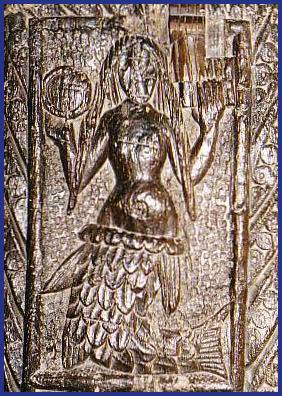
The mermaid's chair within the church, carved from old bench ends is reputed to be around 600 years old. According to a colourful local legend the Mathew Trewella, a handsome young man with an extremely good voice, would sing a solo rendition of closing hymn in church. A mermaid living in neighboring Pendour Cove was enchanted by his voice. The mermaid, it is reported, came into the building and enticed Mathew to a nearby cove, where he followed her beneath the waves and vanished, never to be seen again.
A walk from Zennor to Carn Naun
Distance - 3 miles
Duration - 2.5 hours
*From the car park at Zennor turn left and proceed up the road towards the church. Follow the clear path to Zennor Head.
*After passing the coastguard house at Carn Cobba, the path splits, continue on the path leading to Zennor Head. Pass Porthzennor Cove and proceed along the path climbing to a waymark post, turn left and walk along the clifftops.
*Keep left by a stream then descend sharply through large granite boulders. The path twists down the cliffs, dropping down almost to the sea at Gala Rocks.
*Climb up Tregerthen Cliff and follow the waymarked route, passing over a stile and down the western side of the cliff via the rough rocky steps. Cross a further stream and climb ina landward direction to the next headland of Mussel Point. Cross a stile. then proceed in a seaward direction along the most distinct path to overlook the offshore rocks.
*Continue along the path to the headland of Carn Naun. Retrace your steps to return to the car park at Zennor.